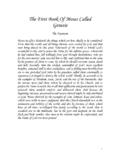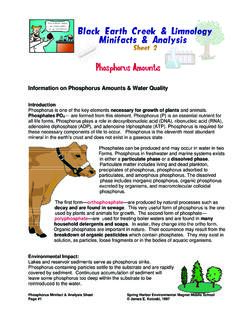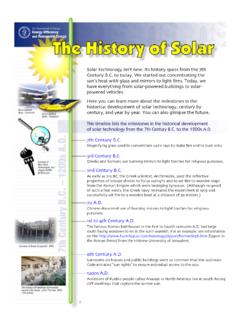Transcription of The Origin and Evolution of Life on Earth
1 AST 309part 2:Extraterrestrial LifeThe Origin and Evolution of life on EarthOverview The formation of Earth Pre-biotic chemistry (Miller-Urey exp.) First evidence for early life The Evolution of life Extreme life on Earth : lessons for astrobiologyA timeline for the very early history of the EarthThe formation of Earth :The Earth formed over ~50 Myr via planetesimal accretionEarth differentiation:Early Earth heats up due to radio-active decay, compression, andimpacts. Over time the temperature ofthe planet interior rises towards the Fe-melting iron "drops" follow gravity andaccumulate towards the core. Lightermaterials, such as silicate minerals,migrate upwards in exchange. These silicate-rich materials may well have risen to the surface in molten form, giving rise to an initial magma ocean After the initial segregation into a central iron (+nickel) core and an outersilicate shell, further differentiation occurred into an inner (solid) and outer(liquid) core (a pressure effect: solid iron is more densely packed than liquidiron), the mantel (Fe+Mg silicates) and the crust (K+Na silicates).
2 Initiallylarge portions of the crust might have been molten - the so called magmaocean. The latter would have cooled to form a layer of basaltic crust (such asis present beneath the oceans today). Continental crust would have formedlater. It is probable that the Earth s initial crust was remelted several timesdue to impacts with large formation of Earth :After condensation of water vapor produced the Earth 's oceans, thussweeping out the carbon dioxide and locking it up into rocks, ouratmosphere was mostly of water by icy planetesimals and comets?Kaboom! The formation of the Moon:Currently favored hypothesis: Earth has a gigantic grazingcollision with a Mars-sizeprotoplanet!It explains the Moon s lower density,lack of iron and oxygen isotope ratiosthat are identical to Earth s (Apollo).A timeline for the very early history of the EarthIn order to be able to find life outside our Earth , we have tounderstand life in our own planet.
3 The chemistry of life and thedifferent processes during the formation and Evolution of theEarth have played a crucial life on Earth a very special thing ?Can life spawn spontaneously elsewhere ?Tiny zircons (zirconium silicate crystals) found in ancient stream deposits indicate thatEarth developed continents and water -- perhaps even oceans and environments inwhich microbial life could emerge -- billion to billion years ago, remarkably soonafter our planet formed. The presence of water on the young Earth was confirmed whenthe zircons were analyzed for oxygen isotopes and the telltale signature of rocks thathave been touched by water was found: an elevated ratio of oxygen-18 to timeline for the very early history of the EarthHow to understand an astrobiologist (or anymicrobiologist):Monomer: usually a small molecule that can bind chemically to form apolymer (amino acids are monomers)Polymer: a macro-molecule composed of repeating structural units.
4 Proteinsand nucleoacids (RNA & DNA) are polymersProtein: a biochemical compound that facilitates a biological functionEncyme: are proteins that catalyze ( increase rates) of chemical reactionsRNA: Ribonucleic acid, a macromolecule made of long chains of nucleotides (1base, 1 sugar and a phosphate group). Single strand, can carrygenetic : Deoxyribonucleic acid, double-helix shaped macromolecule made ofnucleotides. Carries genetic Miller-Urey experimentIn the 1930s, Oparin and Haldane independently suggestedthat ultraviolet radiation from the sun or lightning dischargescaused the molecules of the primordial atmosphere to react toform simple organic (carbon-containing) compounds. Thisprocess was replicated in 1953 by Stanley Miller and HaroldUrey, who subjected a mixture of H2O, CH4, NH3, and H2 to anelectric discharge for about a week. The resulting solutioncontained water-soluble organic compounds, including severalamino acids (which are components of proteins) and otherbiochemically significant experiments only give large yields of interestingorganics (amino acids, nucleic acids, sugars) if the gas isH-rich (highly reducing).
5 If the early atmosphere was CO2+ N2 (mildly reducing), as many suspect, the yields : The assumed atmospheric compositionAtmosphere fromvolcanic outgassing?This would give atmosphererich in CO2, N2, and the composition thatfavors Miller-Urey the original atmosphere have been delivered to the Earth fromcomets, asteroids, ..? Perhaps then the composition would be was the source of the early Earth s atmosphere? Not necessarily endogenous (there from thestart). Outgassing from the crust due to volcanoes (top two), or planetesimal impact (lower left), orcomet vaporization (lower right)? The point here is that a major alternative is exogenous delivery oforganics by comets, asteroids, interplanetary alternative: irradiation of ices,either extraterrestrial, or on a cold young EarthSeveral groups have produced amino acids and other biologically-interesting molecules byultraviolet irradiation of ices meant to resemble what we think interstellar icesare like.
6 Munoz Caro et al. (2002) produced 16 amino acids this way. Hudson et al. (2008) et showed that irradiation of ice with high-energy protons produces amino acids, withoutany other gases present ( doesn t depend on having hydrogen-rich key compound in the ices: Nitriles. In these experiments, it was acetonitrileYou may remember it from the amino acid-like molecule discovered in the interstellarmedium: CH3CN. It is also detected in comets and in Titan s condensation of water vapor produced the Earth 's oceans, thussweeping out the carbon dioxide and locking it up into rocks, ouratmosphere was mostly amino acids have a mirror image (L and D): L and D both found in meteorites L only in organisms on the earthwhy is D selected against?(*)So now we have some amino acids (monomers) loosely mixed in theoceans. Liquid medium is important: Protects molecules from UV photon disruption Ease of transport and InteractionNext goal is to combine Monomers into Polymers (peptide chains)(*) We believe that Earth life 's "choice" of chirality was purely random, andthat if carbon-based life forms exist elsewhere in the universe, their chemistrycould theoretically have opposite monomer?)
7 Which polymer? Monomers (building blocks) polymerized into four types of , only two types seem crucial for primitive biological processes: amino acids/proteins and nucleotides/nucleic acidsDNA-protein system: Too complex for !rst lifeSo which came !rst? The chicken and the egg problem is obvious: Neither DNA norprotein has any function without the other. Yet their symbiosis is fartoo complex to have arisen from nothing. => So what preceded the DNA/protein system?This protein is bendingpart of a DNA, somethingDNA is too stiff to do onits own. There aremyriad other DNA-protein interactions, of DNA is a temptation to think of life " as a protein-making gene system. But this could not havebeen the Origin of life . Not only is it far toocomplex to have developed spontaneously, thereis a chicken-and-egg paradox:No proteins without DNA to code forthem, butNo reason for DNA without proteinsto code they somehow have developed simultaneously?
8 After all, nearly every DNA and RNA in today s lifeoperates only in connection with protein enzymes:protein-DNA interactions are the came before DNA and proteins?Almost certainly: RNARNA looks a lot like DNA, but is single stranded. Thebig difference is that RNA is a molecule that can carryinformation like DNA, but can also fold itself intocomplex three-dimensional shapes like proteins,so RNAs can be their own enzymes (proteins).Because RNA is ribonucleic acid, but can act like anenzyme (protein), these primordial RNAs are called ribozymes and are the most important candidate forthe Origin of life . That is why we are learning about DNA!When naturally occurring ribozymes werediscovered in present-day organisms (including humans),The idea that there was once an RNA world becameeasily the most plausible scenario for the transition to : Prerequisite for RNA world?The production of RNA polymers at fast enough rate is usually considered aproblem, but there are many ways to enhance it.
9 One is to confine the reactants toa compartment of some kind; a lipid vesicle, forerunner of today s lipid membranes (vesicles) are easyHow self-replicating RNA could have led to the DNA/protein worldWhat followed the RNA world? But what preceeded RNA? How could an RNA be alive ? Should we expectthe same on habitable exoplanets? How different could life be if the basicpolymer was not RNA? What if more bases, or more varied codons? Whatare the chances that life would occur again if we could play back the tape ?The lesson we learned so far was that nearly everything that we see today inliving organisms is far too complex to have arisen spontaneously from somelifeless there are two ancient kingdoms, the bacteria and archaea, orthat there are prokaryotic and eukaryotic cells, or that organisms can beclassified according to their metabolic habits, are all interesting, but only showsus that all of these are too complex: They are the products of hundreds ofmillions of years of development and saw a glimmer of what might have come before in timeline for the very early history of the EarthWhen did life begin?
10 Isotope ratios: carbon-12 to carbon-13 abundanceis affected by metabolism in living : Bacterial colonies that usedphotosynthesisMicrofossils: Difficult! estimate: to Gyr agoWhen organisms ingest carbon, they preferentiallyuse 12C over 13C. (14C is radioactive, and thuswon t remain over a long time period.) Carbon with ahigh ratio of 12C compared to 13C is therefore anindicator of living processes. Carbon enriched in 12 Chas been identified in rocks from Greenland dated billions of years ago. This is the earliestevidence for life on biological nature of fossils:stromatolites (below), ..Stomatolites: Mats ofprevious bacterial coloniesthat harvested sunlight forphotosynthesisStromatolites are a classic method for estimating when the Earth s atmospherebecame oxygenated, and some think that the presence of stromatolites at such-and-such an age shows the Earth s atmosphere was oxygenated at that time.









